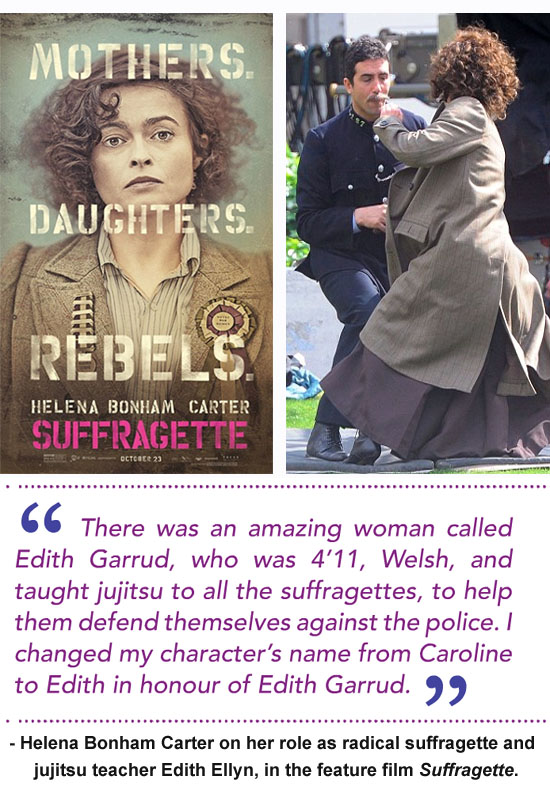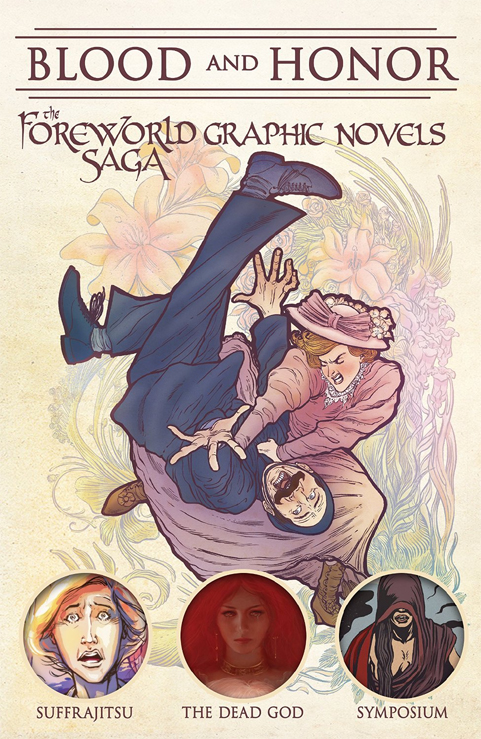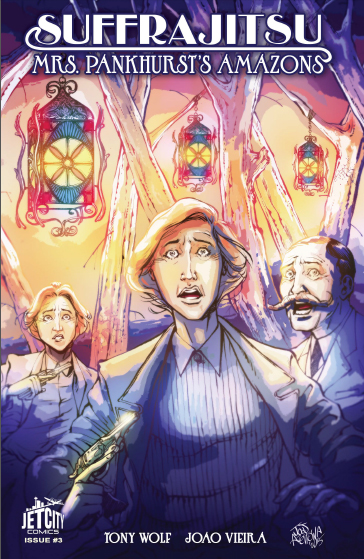Journalist Kate Lismore of Konbini recently interviewed Tony Wolf on the inspirations and process behind the Suffrajitsu graphic novel trilogy:
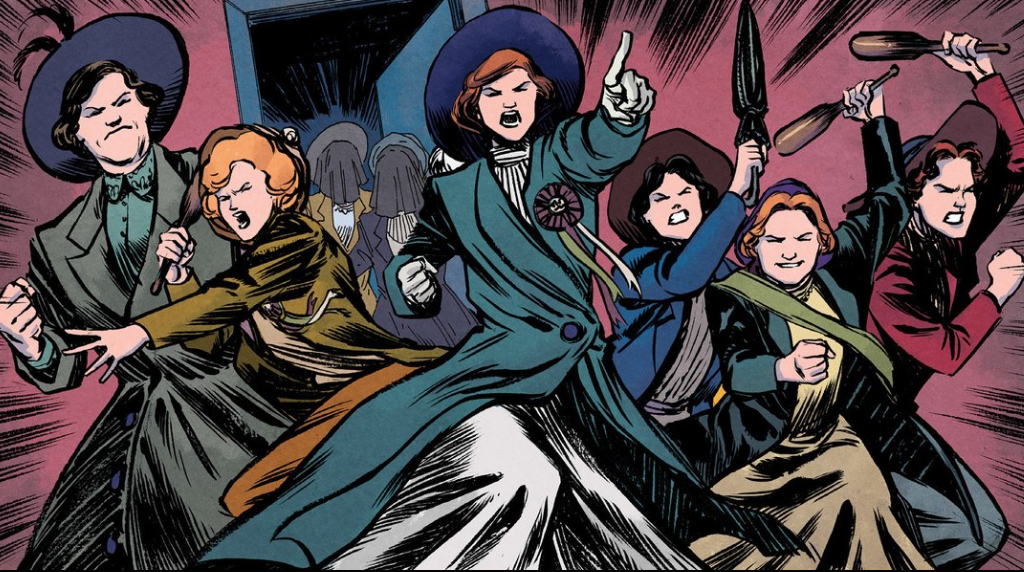
Kate Lismore: What inspired you about the Suffragettes to create your comic/graphic novel?
Tony Wolf: I’d been fascinated by the real-life history of Mrs. Pankhurst’s Amazons for many years, so when Neal Stephenson and Mark Teppo asked me to contribute a graphic novel story to their Foreworld Saga franchise, I jumped at the chance to get creative with that theme.
Given that I’d never actually written a graphic novel before, it was a bit of a leap of faith on Neal’s part to get me involved, and I’m very grateful for the opportunity. He actually makes a guest appearance in the first story, as a well-dressed villain …
Beyond that, though, I just think it’s awesome that a group of women in Edwardian England – “King Edward’s on the throne, it’s the age of men!” as Mr. Banks sings in Mary Poppins – actually risked their safety and freedom, over and over again, to improve the lives of future generations. The fact that some of them were also kick-ass martial arts-trained bodyguards is the icing on the cake.
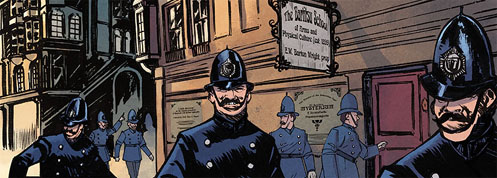
Lismore: What is it about comic book genre that makes moments in history more accessible/engaging for people?
Wolf: I think it’s the appeal of a dramatic character-based narrative over “dry”, academic history, although I love the genres of modern, popular historical nonfiction that are bringing so many amazing stories to light. History is everything that ever happened before now – there’s a lot of very cool stuff in there.
I’m hoping that the Suffrajitsu trilogy, along with the new Suffragette movie, will serve as a kind of edutainment. It’s astounds me that so few people know about the radical suffragette movement. It was an incredibly complex, dramatic and interesting period in recent British history, and yet women’s suffrage is mostly remembered as meek ladies waving placards, Emily Davison being hit by a racehorse and a funny song, also from Mary Poppins.
Obviously, there was a huge amount that, with the best will in the world, I simply couldn’t fit in to a 66-page action-adventure graphic novel, but I tried to communicate certain key points. For one thing, lots of progressive men supported the suffragettes – the newspapers nicknamed them “suffragents” – and lots of conservative women vehemently opposed them, especially as the protest campaigns became more militant. Two male supporting characters, Edward Barton-Wright and Vernon Kell, represent the suffragent perspective in my stories.
There was also a great diversity of opinion among the suffragettes themselves. For example, Christabel Pankhurst, the daughter of Emmeline Pankhurst who led the radical Women’s Social and Political Union, became a strident nationalist during the First World War.
She was a very fierce and intelligent strategist and she campaigned for young men to be shamed into entering the armed forces, by having young women hand them white feathers, symbolic of cowardice. That was extremely controversial at the time, similar to Internet shaming campaigns today. In the Suffrajitsu stories, Persephone Wright, who has been one of Christabel’s loyal bodyguards, takes serious ethical issue with the white feather business.
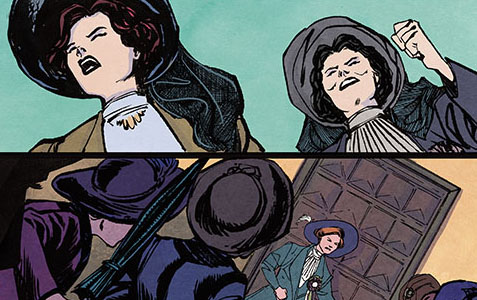
Lismore: Your series focusses on the Amazons and their work protecting the other Suffragettes, how much were you able to take from real life accounts and how much were you able to create for Suffrajitsu?
Wolf: Almost all of the main events in the first issue are very closely based on real-life accounts. Sometimes people hear that Suffrajitsu is an “alternate history” story and jump to the conclusion that the central premise is fictional, but no – there really was a secret society of martial arts-trained women who protected the leaders of the radical English suffragettes!
I think a lot of people are surprised to hear about this because they assume that, if something that awesome really happened, it would be common knowledge by now. Unfortunately, though, as with many interesting social phenomena of the very early 20th century, the Amazons were virtually forgotten in the cultural chaos of the First World War.
It sometimes also happens that people go the other way and assume that Suffrajitsu is supposed to be a verbatim documentary, but the reality is that the story was always intended to combine history and fiction at many levels.
Almost all of the characters are fictional representations of historically real people, the major exception being my main protagonist, Persephone Wright, who is the leader of the Amazon team. Persi is partly inspired by a number of real women, including Gert Harding – the young Canadian who led the Amazons in real life – and Edith Garrud, who was the team’s martial arts instructor. Edith also makes a cameo appearance in the graphic novel, and she’s received quite a lot of press over the past couple of years.
Persi is her own woman, though. She’s what would have been called a “bohemienne”, basically an artistic, free-thinking Edwardian hippie chick, who also happens to be highly trained in the martial arts. She’s bisexual and, like many people during the early 20th century, she’s heavily addicted to cocaine, which was prescribed by doctors as a wonder-cure for all kinds of ailments. In Persi’s case, it was “melancholia”, or what we’d think of as depression, arising from a trauma that occurred when she was seventeen. So, all together she has a pretty complicated life, but fundamentally she’s a person with a very strong drive to protect other people and to fight for what she believes in. Literally, when necessary.
Our representations of the Amazons’ confrontations with the police are very faithful to the historical record, with only minor tweaks for storytelling purposes. That includes the spectacular “Battle of Glasgow”, in which 30 suffragettes brawled with squads of police constables on the St. Andrew’s Hall auditorium stage, in front of an audience of 4000 shocked spectators. Again, yes, that really happened. However, there’s an event at the end of the first story that is a radical departure from history, and that event really spins the adventure off into the Foreworld universe.
That said, the second and third stories are also shot through with historically real characters and locations. Even our main villain was directly based on a real person, although he’s much more powerful and successful in the story than he was in reality – which is a very good thing!
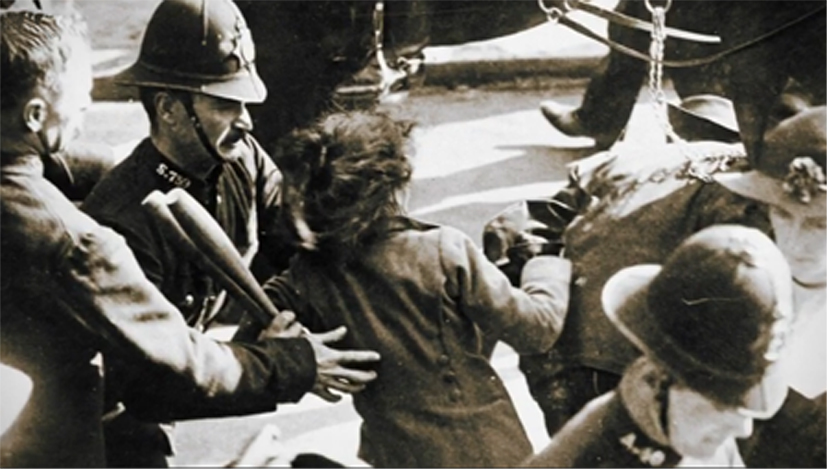
Lismore: Often the term “feminism” is considered a very loaded term; how do you think young men and women can reclaim this and make it more positive?
Wolf: I think that feminism is ideally a position of positive advocacy. For literally as long as I can remember, I’ve understood that all people deserve equal rights and responsibilities, regardless of race, religion, gender, etc. I worked for several years as a women’s self-defence instructor, which enlightened me to some extent as to the power imbalances that still play out every day, everywhere, and I do what I can to redress those imbalances when I have the chance.
The serious risk with any “-ism” is that it mutates over time into a parody of itself. The worst case is that an originally positive, dare-I-say common sense position can degenerate into a kind of dogmatic, conformist control mechanism that supplants individuality, open-mindedness and critical thinking. “Be careful what you hate”, and so-on.
I’m about half a century old now, so young people should feel free to ignore my opinions, but it does give me pause to hear about student activists agitating for “trigger warnings”, “safe spaces” and so-on. I appreciate the sentiment, but I have to say that previous generations, from the suffragettes through to the women’s liberationists and other social activists of the ’60s and ’70s, did not typically portray themselves as victims, except as a tactical choice.
Frankly, students should be seeking out challenges rather than demanding to be protected from ideas that they don’t like. These trends trouble me because I want to be able to respect and support these young men and women as the next generation of social progressives.
So, that’s me being all curmudgeonly. My best advice for the younger generation is to be skeptical, imaginative, curious and honest.
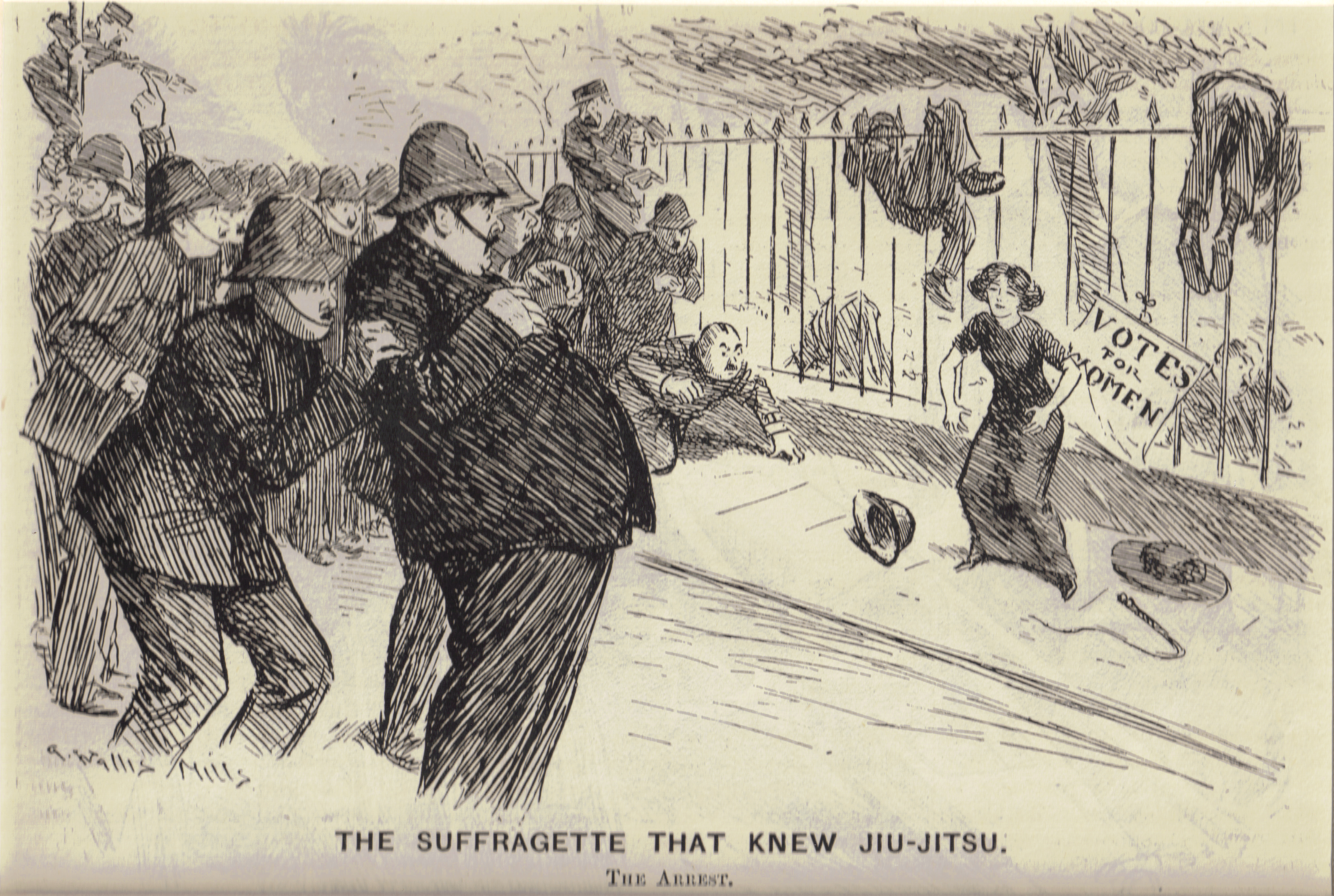
Lismore: How did you learn about the Amazons? Despite learning about women’s suffrage in school I’d never heard of them before.
Wolf: I first learned about the Amazons as a teenager, reading a book on martial arts history which included an anecdote about young London “society girls” shinnying down drainpipes and sneaking off to secret suffragette jiujitsu classes in the dead of night.
The “secret society” aspect – the idea of this cat-and-mouse game between guerilla suffragettes and the police, playing out in the streets at the height of what was almost a state of civil war – struck a very romantic and transgressive chord. I experienced something similar a few years later, during the massive and frequently violent social unrest that erupted during the South African Springbok rugby team tour of New Zealand, when anti-apartheid protesters clashed with rugby fans and police.
When the Internet came along I became seriously involved in reviving Bartitsu, which is an eccentric “mixed martial art” for ladies and gentlemen that was founded in London right at the turn of the 20th century. As I was researching Bartitsu I started to come across more and more information about the suffragette bodyguards.
I included chapters on the Amazons in several Bartitsu-themed books I produced between 2005-2008, and then I wrote the book Edith Garrud: The Suffragette Who Knew Jujutsu, which was intended to interest young teenagers in herstory and in learning self defence. The Amazons were also featured in a Bartitsu documentary that I co-produced in 2011, and I’ve advised on quite a number of articles and academic theses about them over the past few years.
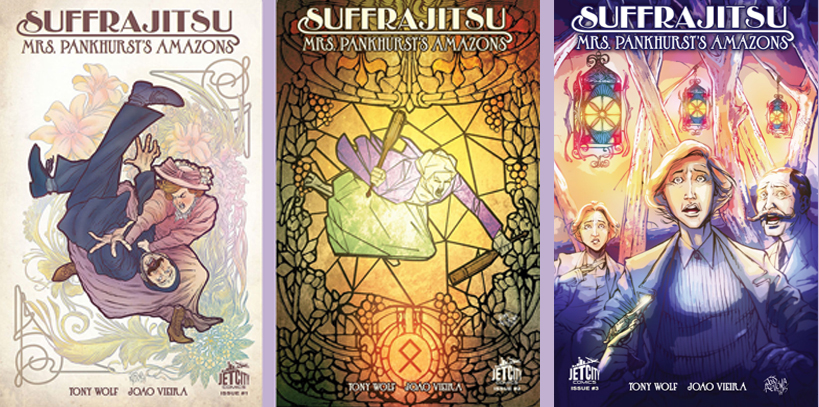
Lismore: You’ve released the trio of Suffrajitsu comics, are there any more adventures in the works?
Wolf: I’d love to do more, and I’ll never say never, but Suffrajitsu was commissioned as a stand-alone, self-contained trilogy. That said, the idea of Mrs. Pankhurst’s Amazon team obviously cries out for expansion beyond what I was able to do in one graphic novel.
Last year I organised a project that brought together four other writers who have produced further adventures set in the Suffrajitsu milieu, incorporating many characters from my stories. I gave the writers advance access to the graphic novel scripts plus a detailed “world guide”, as well as editorial feedback. Their short stories and novellas are now available as e-books via Amazon.com’s Kindle Worlds, which is a platform for licensed fan fiction set in numerous fictional universes, including the Foreworld Saga.
Incidentally, we have an open invitation for writers to contribute their own Suffrajitsu stories via the same scheme, and I hope more people do join in. I enjoyed every bit of the process of developing the Kindle Worlds stories – it was both humbling and deeply satisfying to have others playing in my sandbox!
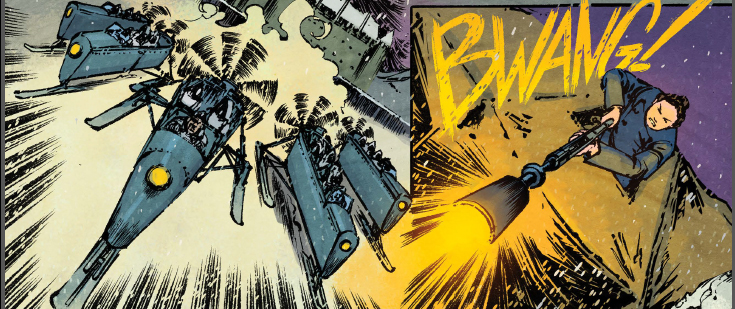
Lismore: Is there much collaboration between your storylines and Joao’s illustration? How did you decide on your strong visual aesthetic?
Wolf: There was a great deal of collaboration over about 12 months, all by email as Joao lives in Brazil and I’m currently based in Chicago, USA. I wrote the graphic novel script as if it were a screenplay, with detailed “stage directions”, etc., anticipating a close collaboration with the artist. Likewise, there was a lot of email collaboration with BOOM! Studio in Seattle, who handled the colouring, lettering etc.
The visual aesthetic was very much a team effort. Joao Vieira has a superb sense of dynamic action and a real flair for illustrating the Edwardian period, plus expertise in framing and “camera angles”, and our colourist, Josan Gonzales, found exactly the right palette. I had strong ideas about certain things – the Art Nouveau covers, etc. – and, because I also work as a fight choreographer for theatre, TV, feature films and video games, I had definite opinions about the Bartitsu action scenes.
I sent Joao a large number of character, item and location reference photographs, which I’d compiled during my years of academic research. Some of those are just little personal touches, like a brandy flask which is shown at one point, which is based on a flask I inherited from my grandfather.
Myself and my wife, Kathrynne, who is an actress, posed for some further reference photographs, and there are also “guest appearances” by my parents and my son Josh, who appears as a back-alley Soho hooligan in the third story.
I also had the chance to revise the script in certain areas, in response to what the art team was doing. I was delighted with the look of the comics. I’m sure this is old hat to experienced graphic novel writers, but there was something magical about having the scenes that I’d been visualising brought to life on the page.
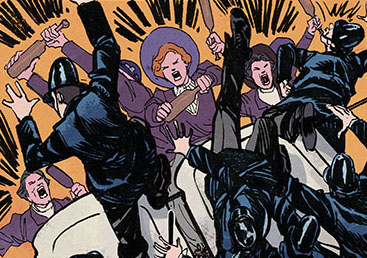
Lismore: If there’s one lesson that today’s society, particularly young women, could learn from the Suffragettes and the Amazons, what do you think it is?
Wolf: To have the courage of their convictions. The group of domestic violence protesters who creatively disrupted the red carpet premiere of Suffragette had the right idea. “Deeds, not words” was the suffragette battle-cry, and I think that has a particular resonance today, when so much of our daily lives are lived in virtual space, bouncing tweets and likes and shares back and forth. The Internet is a fantastic tool, but if you want real-world change, you have to get out there and do it.
 This new Atlas Obscura article by writer Tao Tao Holmes highlights both the Suffrajitsu graphic novels and the real history of the suffragette Amazons, including an interview with Suffrajitsu author Tony Wolf. Here’s an excerpt:
This new Atlas Obscura article by writer Tao Tao Holmes highlights both the Suffrajitsu graphic novels and the real history of the suffragette Amazons, including an interview with Suffrajitsu author Tony Wolf. Here’s an excerpt: Suffragette is literally the first feature film to offer a dramatic representation of the radical women’s suffrage movement in England. As the movie has already been
Suffragette is literally the first feature film to offer a dramatic representation of the radical women’s suffrage movement in England. As the movie has already been  That noted, the film introduces protagonist Maud Watts (Carey Mulligan), a 24 year old East End laundress whose only joy in life is her family – husband Sonny (Ben Whishaw) and young son George (Adam Michael Dodd). Maud was born in the laundry; her mother died there when Maud was a young girl, the victim of an industrial accident, and Maud herself now bears the scars of a lifetime’s labor in that dangerous environment.
That noted, the film introduces protagonist Maud Watts (Carey Mulligan), a 24 year old East End laundress whose only joy in life is her family – husband Sonny (Ben Whishaw) and young son George (Adam Michael Dodd). Maud was born in the laundry; her mother died there when Maud was a young girl, the victim of an industrial accident, and Maud herself now bears the scars of a lifetime’s labor in that dangerous environment.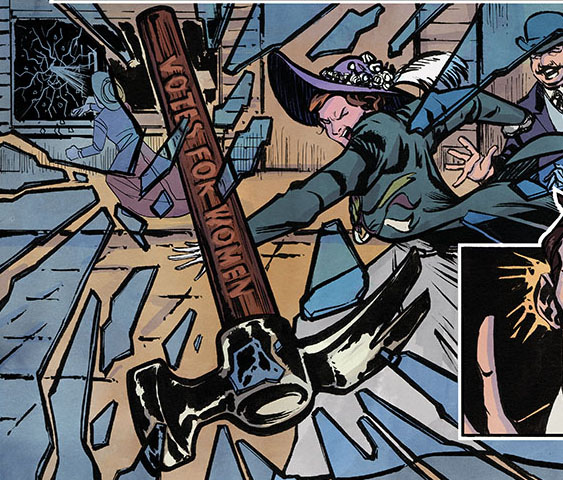
 The police then violently disperse the suffragette crowd, striking women down with their truncheons and dragging them off to prison. The level of violence depicted is on the very extreme end of the scale of reported police action against suffragette protesters. The impression given is that the police assault was virtually unprovoked; this scene may have been inspired by the infamous
The police then violently disperse the suffragette crowd, striking women down with their truncheons and dragging them off to prison. The level of violence depicted is on the very extreme end of the scale of reported police action against suffragette protesters. The impression given is that the police assault was virtually unprovoked; this scene may have been inspired by the infamous 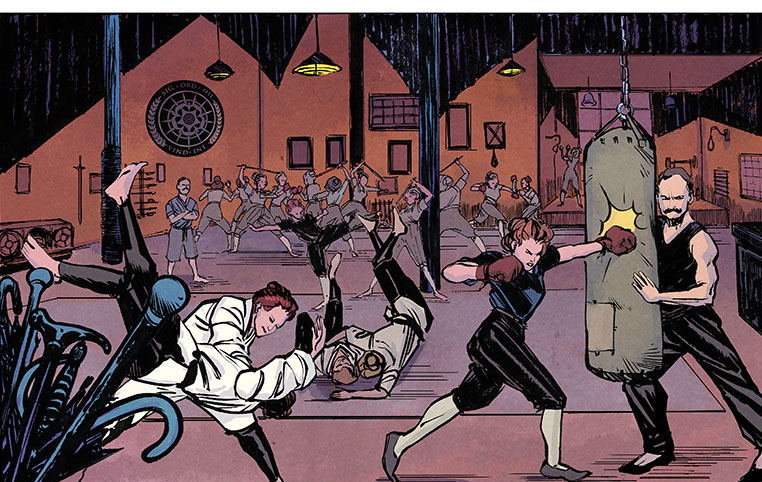

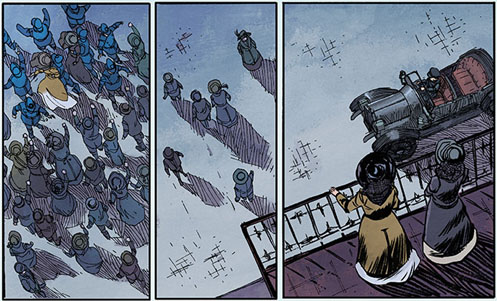
 In sum, we unreservedly recommend the film to fans of the graphic novel. The cast is uniformly excellent and the evocation of London circa 1912/13 is beautifully executed. To some extent, in fact, the events of Suffragette can be viewed as an immediate prequel to those of the Suffrajitsu trilogy; it’s very easy to imagine Maud Watts as one of Mrs. Pankhurst’s Amazons.
In sum, we unreservedly recommend the film to fans of the graphic novel. The cast is uniformly excellent and the evocation of London circa 1912/13 is beautifully executed. To some extent, in fact, the events of Suffragette can be viewed as an immediate prequel to those of the Suffrajitsu trilogy; it’s very easy to imagine Maud Watts as one of Mrs. Pankhurst’s Amazons.







